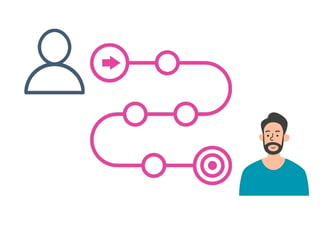How to write great Sales Emails every time
Are All Sales Emails Rubbish? This Article Talks About Debunking the Myth and Mastering the Art of Writing Great Sales Emails
10 min read
 Johanne
:
Jun 27, 2024 10:46:22 AM
Johanne
:
Jun 27, 2024 10:46:22 AM

Personalised email content is a powerful lead generation tool and is an effective way to engage your audience and drive conversions.
Email campaign personalisation is the art of tailoring content to individuals by utilising the data at hand. If we're talking about your existing customers, this could range from recent purchases to location to communication preferences. If we are talking about prospects, it's likely to be information centred on their role and the company they work for.
Personalisation is versatile, spanning from simple tactics like addressing people by their name in the subject line to more advanced strategies such as customising email content based on information available online.
Implementing personalisation in your email campaigns has been proven to boost open and click-through rates significantly, ultimately impacting your ROI and revenue. Research indicates that emails featuring personalised subject lines are 26% more likely to be opened.
The effectiveness of personalised emails lies in their relevance to the recipient. Rather than receiving generic content, personalised emails address recipients directly, include their name, and offer products, services or promotions tailored to their needs.
Three key components contribute to the makeup of a personalised email:
The key foundation of a personalised email lies in its relevance. Inboxes are almost always inundated with emails, with the average person receiving a staggering 120-150 emails daily. To truly enhance email personalisation and captivate your subscriber's interest, providing directly impactful content is crucial. If your content fails to resonate with your reader, there is a high likelihood that your email will be discarded.
2. Timing
Another essential aspect of personalised emails is ensuring timeliness in your communication. By leveraging the data collected about your contacts, you can gain valuable insights into their needs and preferences at different stages of their buyer's journey.
For example, if a contact shows interest in a specific topic or solution on your website, you can understand their current needs and deliver a well-timed email that caters to their interests.
3. Keep it real, make it human
Your audience is more likely to trust and connect with an email that appears to come from an individual rather than a faceless business entity. Enhance the personal touch by using your own name in the “from” field and a friendly face instead of a logo to make the email feel more human.

While our marketing friends will have differing opinions, as a salesperson and a business leader focusing on growth, I would argue there are essentially two main categories of email campaigns - those created for your existing customers and those created for reaching out to potential customers, leads, or prospects.
In this article, we'll be delving into email campaigns aimed at potential customers whom we'll refer to as prospects. This category of email has more than one type and here we focus on the main two;
Brand Awareness Email Campaign: Brand awareness is the first stage of the funnel, so the more potential customers who recognise your brand name, the more likely you are to convert them. Brand awareness campaigns are designed to provide valuable information without any specific calls to action or offers.
These emails are tailored to a particular industry or buyer persona, targeting contacts that are a good fit. While the content is not heavily personalised, it aims to inform and engage recipients within the targeted group to keep your brand at the forefront of their minds.
Sales Email Campaign: Sales campaigns are very different from other email campaigns. Prospecting campaigns and cold email campaigns have different names/forms but are essentially emails to a prospect who is a good fit for your products and services but is not a customer yet. You won't have any purchasing history and more than likely, you won't have a relationship with the contact you are reaching out to.
These Sales emails require more work up front to research each contact and find information to make the email relevant and personal to the prospect. For this reason, they are sent in small batches, enabling them to be totally personalised.
Regardless of the industry or the messaging, an effective sales email should be structured in a straight forward way. While the content of each sales email will vary, there are typically five key components that should be included in every sales email campaign you send:

Personalised email content has a significant impact on engagement with the audience. When recipients receive emails tailored specifically to their interests and preferences, they are more likely to open the email, click on the links, and take the desired action.
By addressing the recipients by their names and providing relevant content - relevant to their role and their company, not just their industry, you can create a sense of personal connection and make the recipients feel you know what challenges they face in their day-to-day work life.
Studies have shown that personalised emails have higher open and click-through rates than generic emails. This is because personalised emails are more relevant to the recipients, making them more likely to engage with the content and less likely to regard them as spam. Research has found that personalisation can increase open rates by up to 26% and click-through rates by up to 97%.
Personalised email content plays a crucial role in building brand loyalty. By delivering tailored content that is relevant and valuable to the recipients, you can strengthen the relationship between the brand and its audience.
One key benefit of personalised email content is that it helps create a personalised experience for the recipients. When recipients receive emails tailored to their needs and interests, they feel understood and valued by the brand. This leads to a deeper connection and a sense of loyalty towards the brand.
Furthermore, personalised email content allows you to deliver targeted offers, recommendations, and promotions to the recipients. By researching the recipient online (LinkedIn, X and their company website) and other online sources, you can send highly relevant emails to each individual. This increases the likelihood of conversion and enhances the overall customer experience.
Another benefit of personalised email content is that it allows for effective customer segmentation. By dividing the email list into different segments based on demographics, interests, etc, you can send highly targeted emails to specific groups of recipients. This ensures that the content is relevant to each segment, increasing the chances of engagement and conversion.
Creating effective personalised email campaigns requires following certain best practices. By implementing these strategies, you can maximise the impact of your email campaigns and achieve better results.

One common challenge faced by B2B Sales teams is the difficulty in reaching and influencing buyers due to limited visibility into their activities.
Research shows that the average software buyer only spends about two minutes on a seller's website. At the same time, they dedicate hours each day to gathering information from various independent sources such as online review sites, research reports and analysts.
Utilising Intent Data can help capture this online activity more effectively. Intent Data tells you when buyers are actively researching online for a solution and which products and services they are interested in based on the web content they consume.
One of the best practices for creating effective personalised email campaigns is to collect and analyse First Party Data. (Information collected from your customer base, subscribers, and site visitors when they interact with your site or campaign, or when they make a purchase).
By understanding the recipients' demographics, interests and browsing behaviour, you can gain valuable insights that can be used to personalise the email content. This data can be collected through sign-up forms, website tracking, and surveys.
Buyer Intent Data is a viable option for creating personalised email campaigns. Using Second-Party Intent Data, you can identify buyers actively researching and considering solutions or services in your industry on other independent websites. This enables you to produce highly targeted content and campaigns that speak directly to prospects' needs.
What is intent Data? And why use is for B2B sales and marketing?
Intent data is derived from user behaviour data such as search history, web visits, ad clicks, and page conversions. In turn, a provider's intent data is derived from the provider's relationship with a user as they collect that behaviour data. For example, first-party intent data is collected from your own channels (e.g., website interactions and email campaigns), and it is considered first-party because you have a direct relationship with the user as you follow them across your website, user communities, and content hubs.
Second-party intent data is behavioural data collected by an organisation that has a direct relationship with the user, like a software. This data is usually collected through a proprietary blend of user registration, product interactions, and on-site behavior tracking that provides helpful context about how to action the data. Once the provider collects this data, they usually aggregate and anonymise it to protect user privacy before selling this information.
Third-party intent data, on the other hand, is collected when the provider has an indirect relationship with the user while it is being collected. These providers monitor thousands and even millions of websites through advertising networks, data sharing, cookies, and search history. These providers typically aggregate the intent data into topical categories using keyword analysis and then anonymise it to meet the standards of broader data privacy regulations. While it offers far-reaching market coverage, key words may offer internal stakeholders less direction on how to action it. It may even require additional processing to clean.
Each type of intent data has its merits, which is why a comprehensive intent data strategy involves blending all three types. Specifically, second-party intent data complements the others by helping you capture mid-funnel intent data so you can follow buyers from the very earliest stages in their search → through building their shortlists → onto your website.
Source - Gartner
Segmenting your email list is another critical practice. By dividing the recipients into different segments based on their characteristics and preferences, marketers can send targeted emails relevant to each segment. This ensures that the content resonates with the recipients and increases the chances of engagement and conversion.
Personalisation goes beyond just addressing the recipients by their names. It involves tailoring the content based on the recipient's interests, preferences, and behaviour. You can use dynamic content or merge tags to insert personalised information into the emails, such as product recommendations, location-specific offers, or even birthday greetings!
Testing and optimisation are also crucial for creating effective personalised email campaigns. You should conduct A/B tests to determine which subject lines, content, and call-to-action buttons perform better. By analysing the results and making data-driven decisions, you can continuously improve the effectiveness of your email campaigns.
Craft, customise and refine your email campaigns seamlessly with HubSpot, without waiting on designers or IT.
You can use simple workflows to empower your team to focus on creating email campaigns by automating follow-up tasks like adding contacts to a list after they click a link in an email.
You can easily create simple workflows in the HubSpot email editor, allowing you to set up automated actions once a trigger is activated. These triggers are events or conditions linked to your email campaign. The following triggers can be used for simple workflows in email campaigns:
After a contact is enrolled in a simple workflow, the actions you configure will be triggered.
For example, you can configure a workflow to automatically add a contact to a specific list if they open or click one of your emails.
Measuring the success of personalised email content is essential for assessing the effectiveness of email marketing campaigns and making data-driven decisions for improvement.
One key metric to measure is the open rate. This indicates the percentage of recipients who opened the email. A higher open rate suggests that the subject line and sender name were compelling and attracted the recipients' attention. By tracking the open rate, you can evaluate the effectiveness of different subject lines and optimise them for better results.
Another important metric is the click-through rate. This measures the percentage of recipients who clicked on the links within the email. A higher click-through rate indicates that the content and call-to-action engaged and motivated the recipients to act. By analysing the click-through rate, you can identify which content and offers resonate better with the audience and optimise the email content accordingly.
Another metric to consider is the conversion rate. This measures the percentage of recipients who completed the desired action, such as making a purchase or filling out a form. By tracking the conversion rate, you can assess the effectiveness of the email content in driving conversions and optimise it to improve the results.
Apart from these metrics, you can also track other engagement metrics, such as the number of unsubscribes, the number of shares or forwards, and the time spent reading the email. These metrics provide additional insights into the recipients' behaviour and help to evaluate the overall success of the personalised email content.
Ultimately, the true test of success for any email campaign is in monitoring the number of meetings it sparks that lead to your company gaining new customers. That's what it's all about!
At the end of the day the ultimate goal of all this effort is to expand your business and land those new clients!
![]() The future of personalised email campaigns looks promising, with advancements in technology and buyer expectations shaping the way we engage with our audience.
The future of personalised email campaigns looks promising, with advancements in technology and buyer expectations shaping the way we engage with our audience.
One of the critical trends in personalised email campaigns is the use of artificial intelligence (AI) and machine learning. These technologies enable us to automate the personalisation process by analysing large amounts of data and delivering highly targeted and relevant content to each individual.
AI can help predict recipients' preferences, optimise the email content, and even create real-time dynamic emails.
Another trend is the integration of email campaigns with other channels and touch-points. Leveraging multi-channel campaign strategies to deliver consistent and personalised experiences across different platforms, such as social media, mobile apps, and websites.
By integrating data from various sources, we can create a unified view of the customer and deliver seamless and personalised experiences throughout the customer journey.
Personalised email marketing is also becoming more interactive and dynamic. Using interactive elements such as quizzes, polls, and surveys within the emails is becoming a popular way to engage the recipients and gather valuable insights.
Moreover, dynamic content creates personalised product recommendations, countdown timers, and live social media feeds, making the emails more engaging and relevant.
Privacy and data protection are also gaining importance in personalised email marketing. With stricter regulations such as GDPR, companies must collect and process customer data transparently and securely. Building trust with the recipients is crucial for the success of personalised email marketing.
Advancements in technology, integration with other channels, interactivity, and a focus on privacy and data protection are driving the future of personalised email campaigns. By embracing these trends, companies can leverage personalisation to engage with their target market and drive new business growth.
If you're interested in sales email campaigns why not get in touch with us for a chat about how this could work for your team. If you'd like help setting it up or simply have a few questions we are happy to help!
The definition of spam email is unsolicited emails sent in bulk.
Good lead generation emails do not fall into this category because they are are sent in small, highly curated batches.
Your research should help uncover relevant facts which you can use to personalise your email. Ideally lead gen emails help the recipient solve a challenge or issue they have.
A better use of salespeople's time is researching the pain points your solutions solve for target prospects.
These personalised messages can then be automated using email templates and automatically sent and tracked in HubSpot.
If you have the urge to send more emails to huge lists you've purchased, you will continue to see declining email results.
Personalised, curated small batches of highly targeted emails are extremely effective, although only one of the tools you should consider in your outreach. Here's a helpful article on B2B lead generation.
Domain reputation is the degree of credibility your company's domain has with email providers like Outlook and Gmail and it has a direct connect with your email deliverability.
If you send lots of emails with a high bounce rate your domain reputation suffers and ultimately mailbox service providers will blacklist your domain.
Mailbox service providers can decide not to deliver your emails, so curating small accurate email lists is important in order to reach your intended target market.
Forbes article: 5 ways to hyper-personalise your emails
How to write great sales emails
Professional email signature generator
HubSpot: Personalised email examples
How a CRM can help your business grow
.webp)
Are All Sales Emails Rubbish? This Article Talks About Debunking the Myth and Mastering the Art of Writing Great Sales Emails

Discover how to generate high-quality manufacturing sales leads with our top 10 strategies for B2B manufacturing firms. Attracting new customers for...

How to get more B2B leads Discover the most effective strategies to increase B2B leads and boost your sales